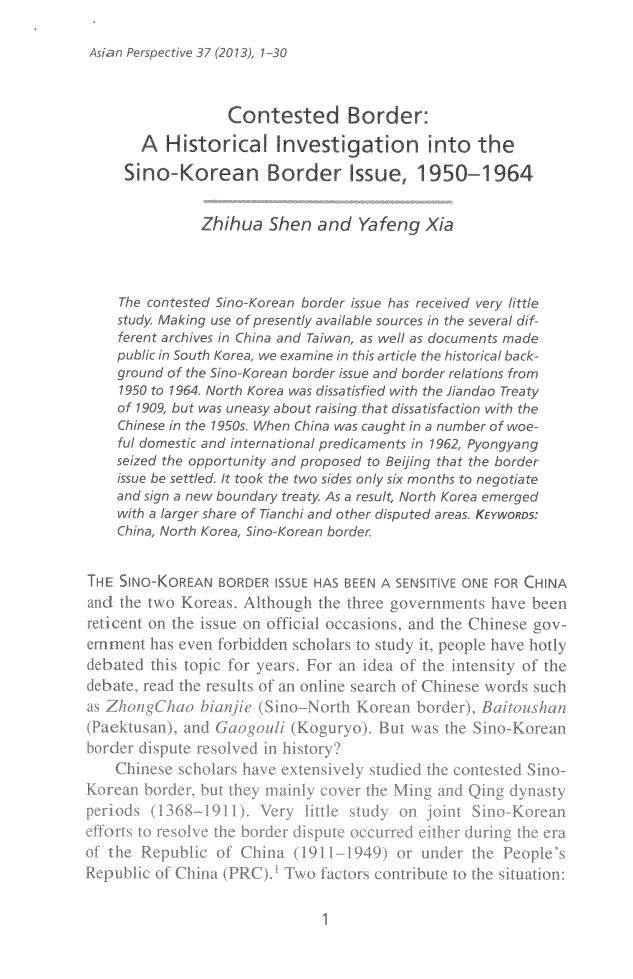
Asian Perspective 37 (2013),1-30 Contested Border: A Historical Investigation into the Sino-Korean Border Issue,1950-1964 Zhihua Shen and Yafeng Xia The contested Sino-Korean border issue has received very little study.Making use of presently available sources in the several dif- ferent archives in China and Taiwan,as well as documents made public in South Korea,we examine in this article the historical back- ground of the Sino-Korean border issue and border relations from 1950 to 1964.North Korea was dissatisfied with the Jiandao Treaty of 1909,but was uneasy about raising that dissatisfaction with the Chinese in the 1950s.When China was caught in a number of woe- ful domestic and international predicaments in 1962,Pyongyang seized the opportunity and proposed to Beijing that the border issue be settled.It took the two sides only six months to negotiate and sign a new boundary treaty.As a result,North Korea emerged with a larger share of Tianchi and other disputed areas.KEywoRDs: China,North Korea,Sino-Korean border. THE SINO-KOREAN BORDER ISSUE HAS BEEN A SENSITIVE ONE FOR CHINA and the two Koreas.Although the three governments have been reticent on the issue on official occasions,and the Chinese gov- emment has even forbidden scholars to study it,people have hotly debated this topic for years.For an idea of the intensity of the debate,read the results of an online search of Chinese words such as ZhongChao bianjie (Sino-North Korean border),Baitoushan (Paektusan),and Gaogouli(Koguryo).But was the Sino-Korean border dispute resolved in history? Chinese scholars have extensively studied the contested Sino- Korean border,but they mainly cover the Ming and Qing dynasty periods (1368-1911).Very little study on joint Sino-Korean efforts to resolve the border dispute occurred either during the era of the Republic of China (1911-1949)or under the People's Republic of China(PRC).Two factors contribute to the situation:
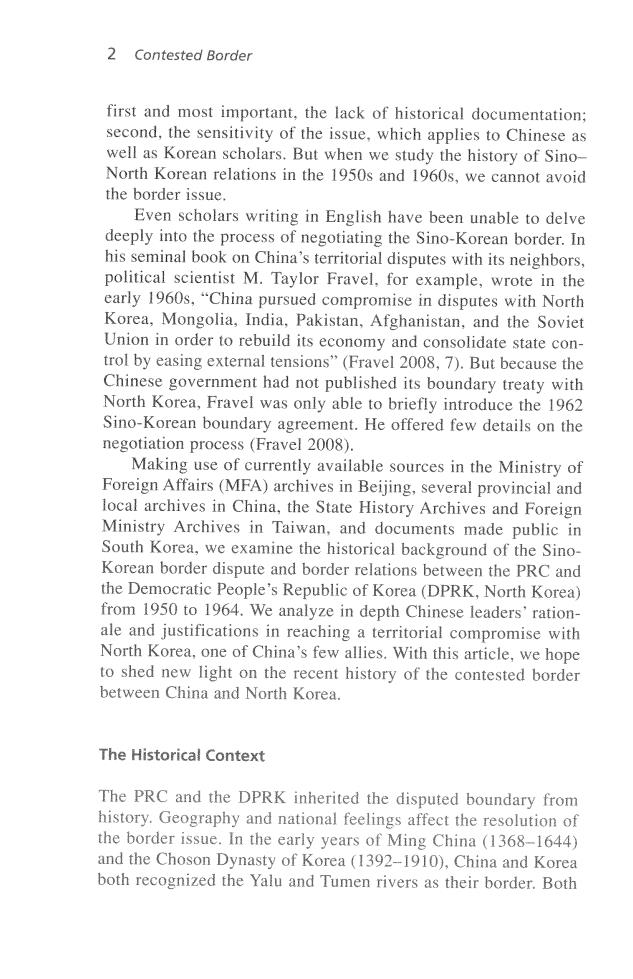
2 Contested Border first and most important,the lack of historical documentation; second,the sensitivity of the issue,which applies to Chinese as well as Korean scholars.But when we study the history of Sino- North Korean relations in the 1950s and 1960s,we cannot avoid the border issue. Even scholars writing in English have been unable to delve deeply into the process of negotiating the Sino-Korean border.In his seminal book on China's territorial disputes with its neighbors, political scientist M.Taylor Fravel,for example,wrote in the early 1960s,"China pursued compromise in disputes with North Korea,Mongolia,India,Pakistan,Afghanistan,and the Soviet Union in order to rebuild its economy and consolidate state con- trol by easing external tensions"(Fravel 2008,7).But because the Chinese government had not published its boundary treaty with North Korea,Fravel was only able to briefly introduce the 1962 Sino-Korean boundary agreement.He offered few details on the negotiation process(Fravel 2008). Making use of currently available sources in the Ministry of Foreign Affairs(MFA)archives in Beijing,several provincial and local archives in China,the State History Archives and Foreign Ministry Archives in Taiwan,and documents made public in South Korea,we examine the historical background of the Sino- Korean border dispute and border relations between the PRC and the Democratic People's Republic of Korea(DPRK,North Korea) from 1950 to 1964.We analyze in depth Chinese leaders'ration- ale and justifications in reaching a territorial compromise with North Korea,one of China's few allies.With this article,we hope to shed new light on the recent history of the contested border between China and North Korea. The Historical Context The PRC and the DPRK inherited the disputed boundary from history.Geography and national feelings affect the resolution of the border issue.In the early years of Ming China(1368-1644) and the Choson Dynasty of Korea(1392-1910),China and Korea both recognized the Yalu and Tumen rivers as their border.Both

Zhihua Shen and Yafeng Xia 3 rivers originate from Changbaishan (Ever-White Mountain in China,Paektusan or White Head Mountain in Korea).Tianchi (called Heavenly Lake in China,Chongji in Korea)atop Chang- baishan is also the source area of the Yalu and Tumen rivers.The boundary is clear below the middle reaches of the Yalu and Tumen because the rivers are wide and deep.But in the upper reaches,the boundary is not clear-cut due to shallow water and unidentified sources of the rivers.Disputes and border incidents have occurred frequently. According to textual research done by Chinese scholars,early Korean kings did not regard Changbaishan as the birthplace of their first ancestor.The Koreans called Changbaishan "mountain in foreign lands."In 1712 the Qing government established the boundary marker along the watershed line about five kilometers south of Tianchi on the Changbaishan,thus reaffirming that China and North Korea were bordered by the Yalu and Tumen(Suh 1988;Goma 2006).Since then,Tianchi,the sacred birthplace of the Qing Dynasty,has been under Chinese jurisdiction.Chang- baishan was defined as the mountain bordering China and Korea. From King Yeongjo(1727-1776)of the Choson Dynasty on,the Koreans have attached greater affection to Changbaishan and revered it as the sacred birthplace of Korean dynasties."Records of King Gojong"(1863-1907)called Changbaishan "our Paektu- san."After Japan's annexation of Korea in 1910,Changbaishan became a symbol for Koreans to cherish the memory of their ancestors and retain their national memory.Today,the DPRK claims that its former leader Kim Jong-il was born there,further complicating the Sino-Korean frontier issue (Yang and Sun 1993; Bianxiezu 1996). In the nineteenth century,China and Korea argued over the source of the Tumen River.While China maintained that the ori- gin of Tumen was the Hongdan River,the Koreans insisted that it was Hongtu Mountain,which is well to the north.To resolve the issue,China and Korea held two negotiations in 1885 and 1887 in order to demarcate the boundary.During the second negotiation, Qing China made an offer:China would give up the Hongdan River claim and accept the Shiyi River (Sogulsu in Korean), which is between the Hongdan River and Hongtu Mountain,as

4 Contested Border the Sino-Korean boundary.The Korean government declined the Chinese offer.After the Russo-Japanese War of 1904.Korea became Japan's protectorate and Japan controlled Korea's diplo- macy and internal affairs.On September 4,1909,China and Japan signed the Jiandao Treaty (Cando in Korean),determining that "China and Korea border along the Tumen River,and the Shiyi River is the boundary in the source area of Tumen."Tianchi on the Changbaishan and its adjacent peaks were declared to be within Chinese territory (Cai 2004,186). After the Allied victory over Japan in August 1945,the Korean peninsula was temporarily divided into two halves along the thirty-eighth parallel on the basis of an agreement between the Soviet Union and the United States.Nearly all Koreans were opposed to this division,and the Korean people aspired to form an independent country.But after the outbreak of the Cold War in Europe,the peninsula came under the control of two independent regimes in 1948.Meanwhile,the Korean people started to ques- tion the legitimacy of the Cando Treaty,with South Korea first to raise the issue(Yang 1998).But a resolution depended largely on the attitude of North Korea,which was under Soviet control.In April 1947 Xiong Shihui,director of the Chinese Nationalist gov- ernment's northeast field headquarters,twice cabled the foreign ministry to report survey and mapping activities by Soviet special agents in the Changbaishan region and in North Korea (Tang 2001).On August 26 the Chinese Foreign Ministry presented a note to the Soviet Embassy in China regarding the Soviets'mov- ing the Sino-Soviet boundary markers without China's permission (Tang2001). During the ensuing Chinese civil war (1946-1949),Yanbian was under Chinese Communist Party (CCP)control.The CCP government did not foresee any serious dispute between China and North Korea over the border(Cathcart 2010).The CCP Yan- bian prefectural committee pointed out in an August 1948 docu- ment that the China-Korea border along the Tumen River had been delimited long ago on the basis of nature and thus on the whole presented no problem.At a certain place,the change in river course or formation of a new tributary led to the conver- gence of villages and land of the two countries.Disputes thus

Zhihua Shen and Yafeng Xia 5 occurred.It was thus necessary,said the committee,to use the main stream as the boundary and let residents on both sides decide whether they would like to remain where they were or move to their motherland (Yanbian Chaoxianzu Archive 1985). New China's Policies on the Resolution of Border Issues Setting Principles for Dealing with Old Treaties After 1949 the PRC government adopted a prudent policy on bor- der issues.In the early 1950s the central government adopted "dilatory tactics"in handling border issues with countries on China's periphery,mainly due to two factors:(1)the Chinese gov- ernment had little knowledge of its borders with its neighbors,and (2)Beijing was heavily involved in the Korean War.The PRC "neither acknowledged nor denied the border treaties or agree- ments"signed between former Chinese governments and foreign governments (Liao 2004).Concerning unresolved border issues, Beijing adopted a policy of maintaining the status quo.But it also instructed relevant government departments to study these issues and actively prepare for their resolution (Liao 2004). In April 1950 North Korea proposed to the northeast people's government of the PRC negotiation of navigation along the Yalu, and it delivered a DPRK-drawn map.The PRC Ministry of For- eign Affairs(MFA)responded by saying,"The DPRK proposal to establish navigation markers in the Yalu River involves China's territorial sovereignty.This issue has to be negotiated between the MFA of China's Central Government and the DPRK.It should not be handled locally"(CFMA No.106-00021-03,4).The MFA asked the foreign affairs bureau of the northeast people's govern- ment to suspend negotiations and deliver all documents to Bei- jing.The MFA would establish new principles after carefully reviewing the issue.We have yet to learn the outcome of the case, which demonstrated the PRC central government's cautious approach toward border disputes as well as the tightening of cen- tral-local relations in the years immediately following the CCP's victory
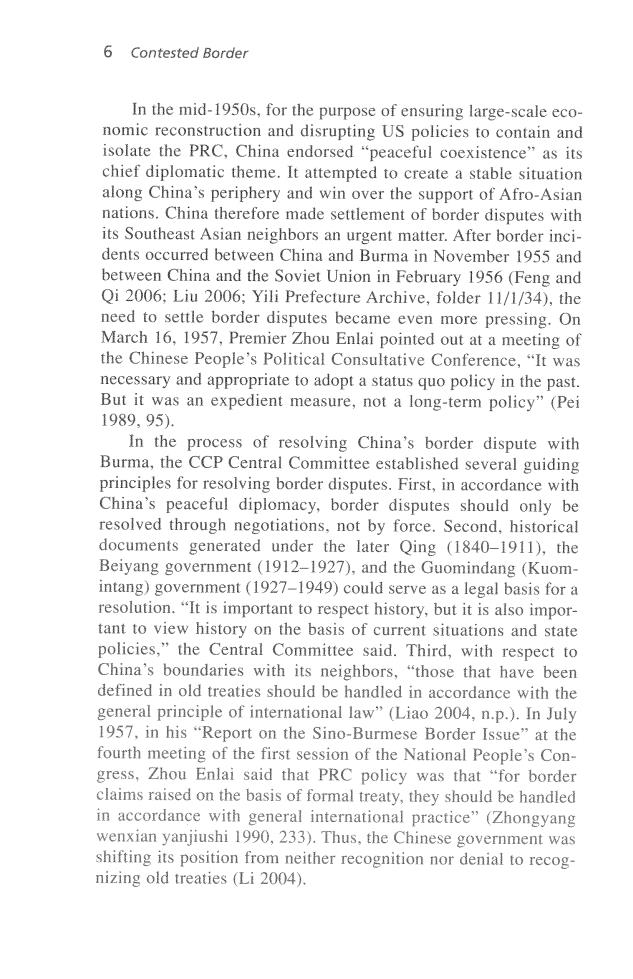
6 Contested Border In the mid-1950s,for the purpose of ensuring large-scale eco- nomic reconstruction and disrupting US policies to contain and isolate the PRC,China endorsed "peaceful coexistence"as its chief diplomatic theme.It attempted to create a stable situation along China's periphery and win over the support of Afro-Asian nations.China therefore made settlement of border disputes with its Southeast Asian neighbors an urgent matter.After border inci- dents occurred between China and Burma in November 1955 and between China and the Soviet Union in February 1956(Feng and Qi 2006:Liu 2006;Yili Prefecture Archive,folder 11/1/34),the need to settle border disputes became even more pressing.On March 16,1957,Premier Zhou Enlai pointed out at a meeting of the Chinese People's Political Consultative Conference,"It was necessary and appropriate to adopt a status quo policy in the past. But it was an expedient measure,not a long-term policy"(Pei 1989,95). In the process of resolving China's border dispute with Burma,the CCP Central Committee established several guiding principles for resolving border disputes.First,in accordance with China's peaceful diplomacy,border disputes should only be resolved through negotiations,not by force.Second,historical documents generated under the later Qing (1840-1911),the Beiyang government(1912-1927),and the Guomindang (Kuom- intang)government (1927-1949)could serve as a legal basis for a resolution."It is important to respect history,but it is also impor- tant to view history on the basis of current situations and state policies,"the Central Committee said.Third,with respect to China's boundaries with its neighbors,"those that have been defined in old treaties should be handled in accordance with the general principle of international law"(Liao 2004,n.p.).In July 1957,in his"Report on the Sino-Burmese Border Issue"at the fourth meeting of the first session of the National People's Con- gress,Zhou Enlai said that PRC policy was that "for border claims raised on the basis of formal treaty,they should be handled in accordance with general international practice"(Zhongyang wenxian yanjiushi 1990,233).Thus,the Chinese government was shifting its position from neither recognition nor denial to recog- nizing old treaties(Li 2004)
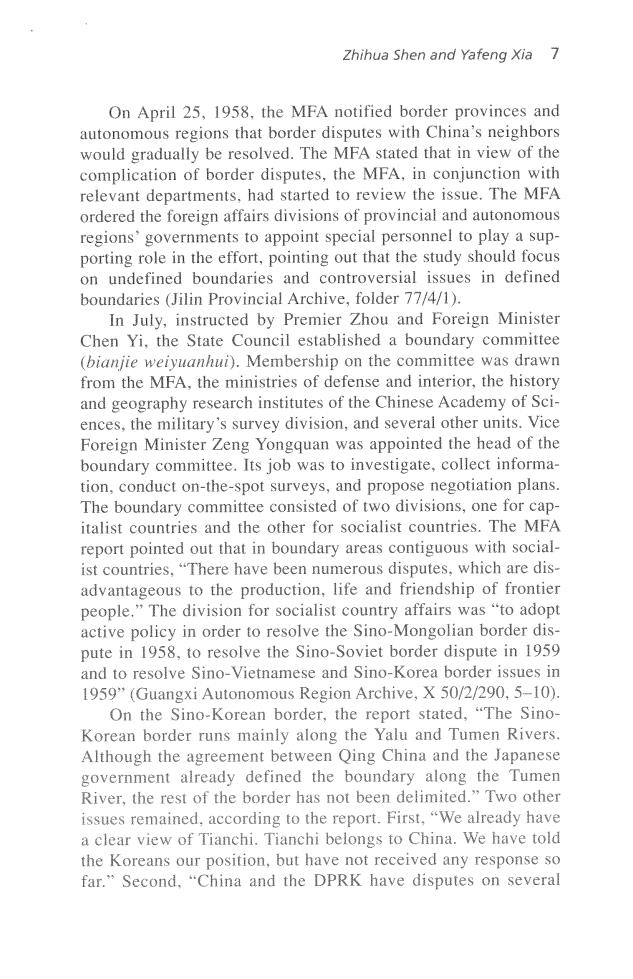
Zhihua Shen and Yafeng Xia 7 On April 25,1958,the MFA notified border provinces and autonomous regions that border disputes with China's neighbors would gradually be resolved.The MFA stated that in view of the complication of border disputes,the MFA,in conjunction with relevant departments,had started to review the issue.The MFA ordered the foreign affairs divisions of provincial and autonomous regions'governments to appoint special personnel to play a sup- porting role in the effort,pointing out that the study should focus on undefined boundaries and controversial issues in defined boundaries (Jilin Provincial Archive,folder 77/4/1). In July,instructed by Premier Zhou and Foreign Minister Chen Yi,the State Council established a boundary committee (bianjie weiyuanhui).Membership on the committee was drawn from the MFA,the ministries of defense and interior,the history and geography research institutes of the Chinese Academy of Sci- ences,the military's survey division,and several other units.Vice Foreign Minister Zeng Yongquan was appointed the head of the boundary committee.Its job was to investigate,collect informa- tion,conduct on-the-spot surveys,and propose negotiation plans. The boundary committee consisted of two divisions,one for cap- italist countries and the other for socialist countries.The MFA report pointed out that in boundary areas contiguous with social- ist countries,"There have been numerous disputes,which are dis- advantageous to the production,life and friendship of frontier people."The division for socialist country affairs was "to adopt active policy in order to resolve the Sino-Mongolian border dis- pute in 1958,to resolve the Sino-Soviet border dispute in 1959 and to resolve Sino-Vietnamese and Sino-Korea border issues in 1959"(Guangxi Autonomous Region Archive,X 50/2/290,5-10). On the Sino-Korean border,the report stated,"The Sino- Korean border runs mainly along the Yalu and Tumen Rivers. Although the agreement between Qing China and the Japanese government already defined the boundary along the Tumen River,the rest of the border has not been delimited."Two other issues remained,according to the report.First,"We already have a clear view of Tianchi.Tianchi belongs to China.We have told the Koreans our position,but have not received any response so far."Second,"China and the DPRK have disputes on several

8 Contested Border small islets due to the changed course of rivers."The boundary commission asked frontier provinces to investigate and send reports on the islets(Guangxi Autonomous Region Archive,X 50/2/290,5-10).It is evident that the MFA did not anticipate any serious issues concerning the shared border between China and North Korea. On August 8,1958,the State Council issued a notice that urged frontier provinces and autonomous regions to establish small groups on boundary work (bianjie gongzuo xiaozu)that would be in charge of border issues within their jurisdiction (Guangxi Autonomous Region Archive,X 50/2/290).On Decem- ber 13,the Central Committee of the CCP issued "Instructions on Strengthening Border Work."It stated that China had a long border and that there were historically inherited as well as new issues in undefined areas.Even in areas where the border was thought to be well defined,zones of unspecified boundaries were present.The boundary commission had little prior information on these bound- aries,such as historical documents,diplomatic files,or accurate maps.It had even less information on the undefined areas.It was understandable that this set of circumstances led to great difficulty in planning for border defense and diplomatic negotiations.The Central Committee emphatically pointed out that"border affairs should be on the routine agenda of the CCP committees of provinces and autonomous regions bordering on nationalist [i.e., nonaligned]countries"(Guangxi Autonomous Region Archive,X 50/2/258,37-38).It seems that the Central Committee did not place the resolution of border issues with socialist countries on its list of priorities. Difficulties Arise over the Sino-Korean Border Nonetheless,the Sino-Korean border disputes were not swiftly resolved.The boundary commission was not able to come up with a negotiation plan in 1958.One of the possible contributing fac- tors is that the Sino-Korean border issue was much more compli- cated than originally anticipated,and thus surveys and investigations were postponed.Furthermore,unforeseen new issues emerged in the border dispute,as detailed below.Clashes
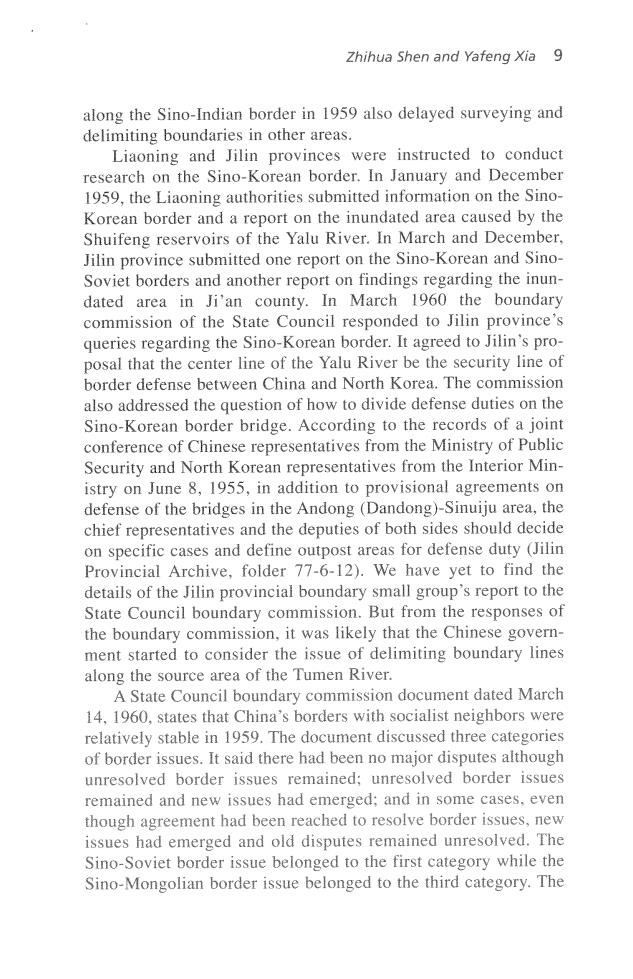
Zhihua Shen and Yafeng Xia 9 along the Sino-Indian border in 1959 also delayed surveying and delimiting boundaries in other areas. Liaoning and Jilin provinces were instructed to conduct research on the Sino-Korean border.In January and December 1959,the Liaoning authorities submitted information on the Sino- Korean border and a report on the inundated area caused by the Shuifeng reservoirs of the Yalu River.In March and December. Jilin province submitted one report on the Sino-Korean and Sino- Soviet borders and another report on findings regarding the inun- dated area in Ji'an county.In March 1960 the boundary commission of the State Council responded to Jilin province's queries regarding the Sino-Korean border.It agreed to Jilin's pro- posal that the center line of the Yalu River be the security line of border defense between China and North Korea.The commission also addressed the question of how to divide defense duties on the Sino-Korean border bridge.According to the records of a joint conference of Chinese representatives from the Ministry of Public Security and North Korean representatives from the Interior Min- istry on June 8,1955,in addition to provisional agreements on defense of the bridges in the Andong(Dandong)-Sinuiju area,the chief representatives and the deputies of both sides should decide on specific cases and define outpost areas for defense duty (Jilin Provincial Archive,folder 77-6-12).We have yet to find the details of the Jilin provincial boundary small group's report to the State Council boundary commission.But from the responses of the boundary commission,it was likely that the Chinese govern- ment started to consider the issue of delimiting boundary lines along the source area of the Tumen River. A State Council boundary commission document dated March 14,1960,states that China's borders with socialist neighbors were relatively stable in 1959.The document discussed three categories of border issues.It said there had been no major disputes although unresolved border issues remained;unresolved border issues remained and new issues had emerged;and in some cases,even though agreement had been reached to resolve border issues,new issues had emerged and old disputes remained unresolved.The Sino-Soviet border issue belonged to the first category while the Sino-Mongolian border issue belonged to the third category.The
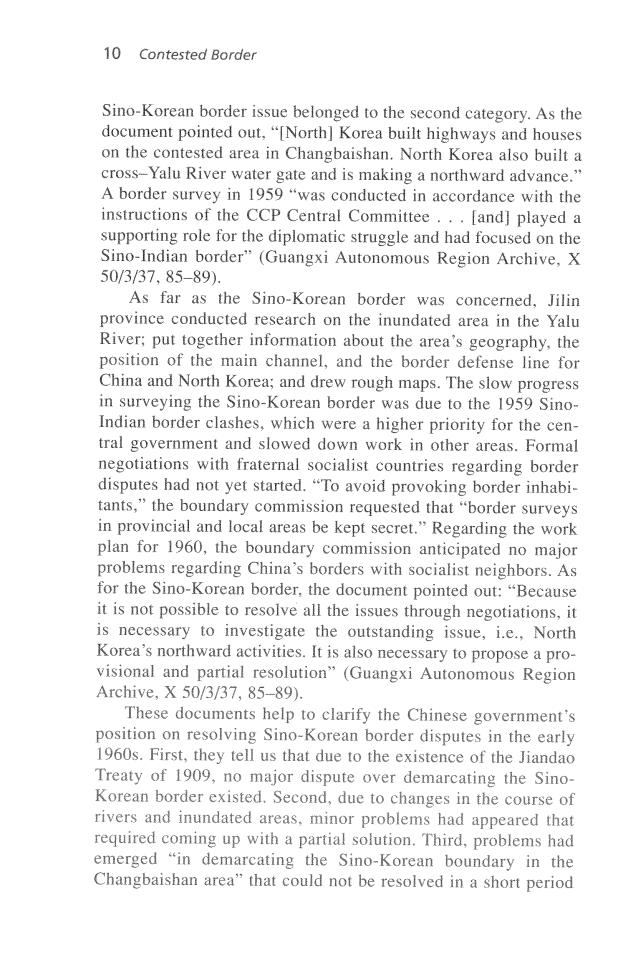
10 Contested Border Sino-Korean border issue belonged to the second category.As the document pointed out,"[North]Korea built highways and houses on the contested area in Changbaishan.North Korea also built a cross-Yalu River water gate and is making a northward advance." A border survey in 1959"was conducted in accordance with the instructions of the CCP Central Committee...[and]played a supporting role for the diplomatic struggle and had focused on the Sino-Indian border"(Guangxi Autonomous Region Archive,X 50/3/37,85-89). As far as the Sino-Korean border was concerned,Jilin province conducted research on the inundated area in the Yalu River:put together information about the area's geography,the position of the main channel,and the border defense line for China and North Korea;and drew rough maps.The slow progress in surveying the Sino-Korean border was due to the 1959 Sino- Indian border clashes,which were a higher priority for the cen- tral government and slowed down work in other areas.Formal negotiations with fraternal socialist countries regarding border disputes had not yet started."To avoid provoking border inhabi- tants,"the boundary commission requested that "border surveys in provincial and local areas be kept secret."Regarding the work plan for 1960,the boundary commission anticipated no major problems regarding China's borders with socialist neighbors.As for the Sino-Korean border,the document pointed out:"Because it is not possible to resolve all the issues through negotiations,it is necessary to investigate the outstanding issue,i.e.,North Korea's northward activities.It is also necessary to propose a pro- visional and partial resolution"(Guangxi Autonomous Region Archive,X50/3/37,85-89). These documents help to clarify the Chinese government's position on resolving Sino-Korean border disputes in the early 1960s.First,they tell us that due to the existence of the Jiandao Treaty of 1909,no major dispute over demarcating the Sino- Korean border existed.Second,due to changes in the course of rivers and inundated areas,minor problems had appeared that required coming up with a partial solution.Third,problems had emerged "in demarcating the Sino-Korean boundary in the Changbaishan area"that could not be resolved in a short period